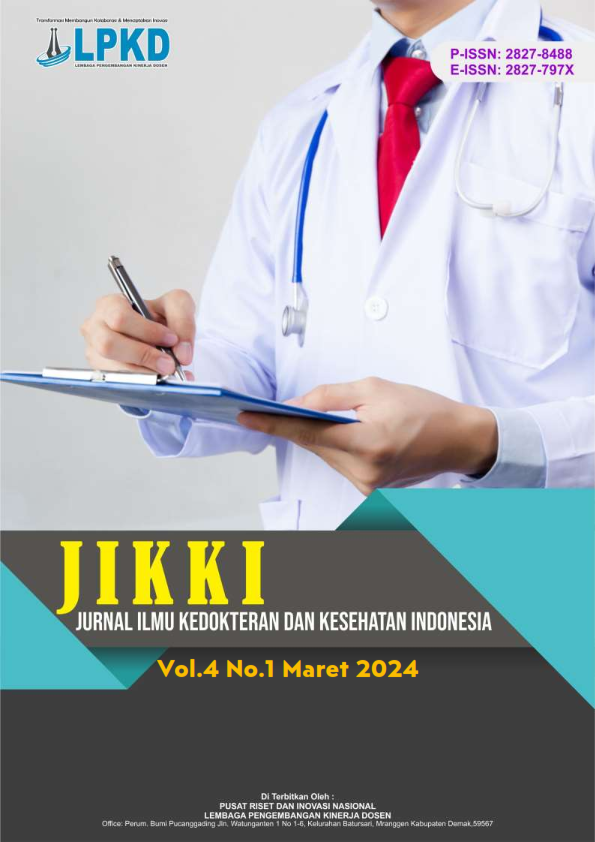Peranan Sekuen Diffusion Weighted Imaging (DWI) Pada Pemeriksaan MRI Soft Tissue Leher Kasus Kanker Nasofaring (Studi Literatur)
DOI:
https://doi.org/10.55606/jikki.v4i1.2638Keywords:
The Role of Diffusion Weighted Imaging Sequences, MRI Soft Tissue Neck Examination, Nasopharyngeal Cancer CasesAbstract
The aim of this research is to determine the role of the Diffusion Weighted Imaging (DWI) sequence in Soft Tissue MRI examinations of the neck in cases of nasopharyngeal cancer and to determine the advantages of using the Diffusion Weighted Imaging (DWI) sequence in MRI Soft Tissue examinations of the neck in cases of nasopharyngeal cancer. The research method used was a descriptive qualitative research method with a literature study method. The results of the literature review research showed: 1) Nasopharyngeal cancer, especially squamous cell carcinoma, can be treated with radiation therapy where treatment failure is still a serious problem, especially in advanced cases. DWI and ADC are imaging methods that utilize the movement of water inside. DWI provides additional information regarding response to treatment in hard-to-reach cases of nasopharyngeal cancer. plays an important role in detection, evaluation of response to treatment, and early monitoring of chemoradiotherapy therapy. DWI also provides information that helps distinguish between tissue experiencing post-RTH fibrosis and areas that may contain active cancer cells. DWI and ADC are also useful in tumor staging, delineation of target volumes, and detection of tumor recurrence. Elevated ADC may be indicative of a favorable response to therapy, whereas low pretreatment ADC values may predict a favorable response. In the diagnosis of nasopharyngeal cancer, DWI and ADC also help differentiate squamous cell carcinoma subtypes, predict response to chemoradiation therapy, and determine the appropriate time for alternative treatment regimens. 2) DWI and ADC provide advantages in the diagnosis and monitoring of nasopharyngeal cancer. DWI can image restrictions on water diffusion within tissue, helping to detect areas of high cell density associated with tumors. Its advantages include sensitivity to microenvironmental changes and the ability to early identify recurrence or secondary cancer post-radiation therapy.
References
Lampung P, Tahun P. Hubungan Antara Faktor Risiko Dengan Kejadian Karsinoma Nasofaring Di RSUD Dr. H. Abdul Moeloek Provinsi Lampung. 2018;2017.
Paulsen F, Waschke J. Sobotta Atlas of Anatomy. 2018. p. 1376.
HK.01.07/MENKES/684/2019 KMKRIN. Pedoman Nasional Pelayanan Kedokteran Tata Laksana Kanker Nasofaring. 2019;1–81.
Stan DJ, Niculet E, Lungu M, Onisor C. Nasopharyngeal carcinoma : A new synthesis of literature data ( Review ). 2022;1–7.
Yu H, Yin X, Mao Y, Chen M, Tang Q, Yan S. The global burden of nasopharyngeal carcinoma from 2009 to 2019 : an observational study based on the Global Burden of Disease Study. Eur Arch Oto-Rhino-Laryngology [Internet]. 2021;(0123456789). Available from: https://doi.org/10.1007/s00405-021-06922-2
Adham M, Kurniawan AN, Muhtadi AI, Roezin A, Hermani B, Gondhowiardjo S, et al. Original Article. :185–96.
Ashby K, Adams BN, Shetty M. Appropriate Magnetic Resonance Imaging Ordering. 2020;
Dale BM, Brown MA, Semelka RC. MRI: basic principles and applications. John Wiley & Sons; 2015.
Torsten B. Moeller ER. MRI Parameters and Positioning,2nd Edition.Thieme. Nuevos sistemas de comunicación e información. 2010. 2013–2015 p.
Burghart G. Handbook of MRI scanning. 2012. 405 p.
Elmaoğlu M, Azim Celik. MRI Handbook MR Physics, Patient Positioning and Protocols. 1st editio. Springer New York Dordrecht Heidelberg London. Antalya Turkey: Springer; 2012. 12–26 p.
Catherine Westbrook. Handbook of MRI Technique. Fourth Edi. Garsington Road, Oxford, OX4 2DQ U, editor. Vol. 4, John Wiley & Sons, Ltd. The Atrium, Southern Gate, Chichester, West Sussex, PO19 8SQ, UK; 2014. 88–100 p.
Salem F, Elshafey R. Apparent diffusion coefficient measurements in the differentiation between benign and malignant neck masses. Egypt J Radiol Nucl Med [Internet]. 2014;45(2):367–75. Available from: http://dx.doi.org/10.1016/j.ejrnm.2014.01.011
Mui AWL, Lee AWM, Lee VHF, Ng WT, Vardhanabhuti V, Shei S, et al. Prognostic and therapeutic evaluation of nasopharyngeal carcinoma by dynamic contrast-enhanced ( DCE ), diffusion-weighted ( DW ) magnetic resonance imaging ( MRI ) and magnetic resonance spectroscopy ( MRS ). 2021;83(April):50–6.
Lampignano JP, Kendrick LE. Bontrager’s textbook of radiographic positioning and related anatomy. 9th Editio. St. Louis, Amerika.: Elsevier Inc; 2018. 850 p.
Paulsen F, Böckers TM, Waschke J, Winkler S, Dalkowski K, Mair J, et al. Sobotta anatomy textbook: English edition with Latin nomenclature. Elsevier Health Sciences; 2018.
Frank H, Netter MD. Atlas of human anatomy. Elsevier Inc.; 2019.
Vijay V, Naomi G, Niles N, Ruth Y, Navid H, Kate A, et al. MRI detection of suspected nasopharyngeal carcinoma : a systematic review and meta ‑ analysis. Neuroradiology [Internet]. 2022;1471–81. Available from: https://doi.org/10.1007/s00234-022-02941-w
Shah AB, Nagalli S. Nasopharyngeal Carcinoma. In Treasure Island (FL); 2023.
Bright A. Planning and Positioning in MRI. Vol. 88, AJN, American Journal of Nursing. 2015. 664–667 p.
Catherine Westbrook JT. MRI In Practice. 1st ed. Vol. 4. 2019. 88–100 p.
Hirshoren N, Damti S, Weinberger J, Meirovitz A, Sosna J, Eliashar R, et al. Diffusion weighted magnetic resonance imaging of pre and post treatment nasopharyngeal carcinoma. Surg Oncol [Internet]. 2019;30(July):122–5. Available from: https://doi.org/10.1016/j.suronc.2019.07.005
Saied H, Ghany A, Fayez M, Samra A, El-saieed M, Saber A, et al. The Egyptian Journal of Radiology and Nuclear Medicine Role of DW-MRI and ADC value in monitoring therapy of head and neck squamous cell carcinoma. Egypt J Radiol Nucl Med [Internet]. 2018;49(4):1030–5. Available from: https://doi.org/10.1016/j.ejrnm.2018.07.016
Squamous N, Carcinoma C, Morphologic W, Criteria MRI. HEAD & NECK MRI with DWI for the Detection of Posttreatment. 2018;1–8.
Downloads
Published
How to Cite
Issue
Section
License
Copyright (c) 2023 Jurnal Ilmu Kedokteran dan Kesehatan Indonesia

This work is licensed under a Creative Commons Attribution-ShareAlike 4.0 International License.








